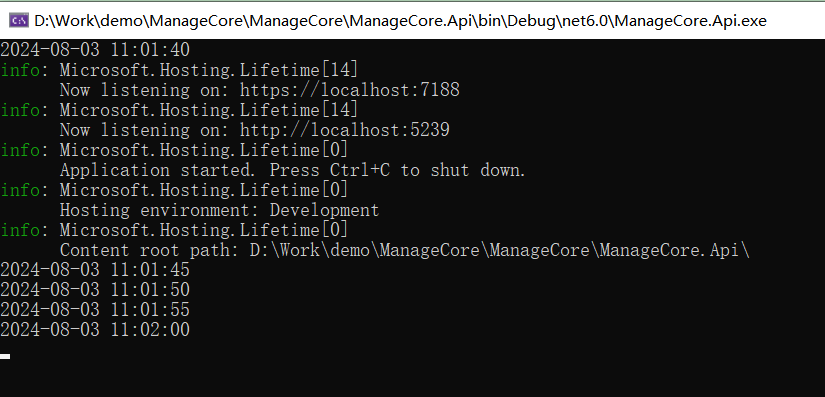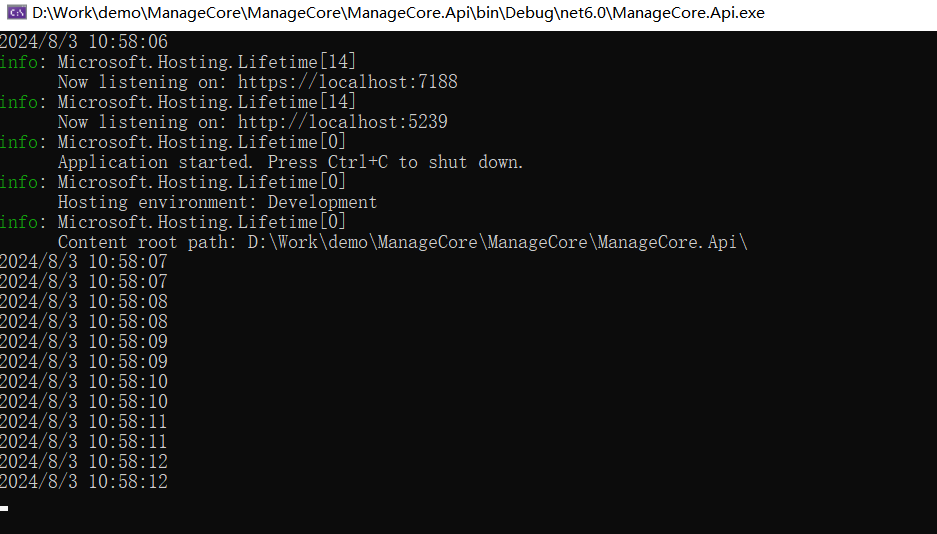前言
在.NET 8中,IHostedService 和 BackgroundService 两个核心接口的引入,增强了项目开发中处理定时任务的能力。这两个接口不仅简化了定时任务、后台处理作业以及定期维护任务的实现过程,还提升了在ASP.NET Core 或任何基于.NET的宿主应用程序中的集成与管理效率。
IHostedService接口提供了一个基本的框架,允许自定义后台服务的启动和停止逻辑。通过实现该接口,可以灵活地控制服务的生命周期,确保任务在应用程序启动时自动运行,并在应用程序关闭时结束。
而 BackgroundService 类则是对 IHostedService 接口的进一步封装,它专为需要长时间运行的任务而设计。
通过继承 BackgroundService并重写其 ExecuteAsync方法,可以轻松地实现复杂的后台逻辑,如循环执行的任务、基于时间间隔的操作等。这种设计模式让代码的可读性和可维护性变的更好。
利用这些功能,可以快速构建出高效、可靠的定时任务系统,用于执行诸如消息推送、数据更新、定时发布等关键业务操作。这些任务可以在不影响应用程序主流程的情况下独立运行,从而提高了整个系统的性能和稳定性。
介绍
.NET 中的后台服务允许在后台独立于主应用程序线程运行任务。这对于需要连续或定期运行而不阻塞主应用程序流的任务至关重要。
IHostedService
IHostedService 是一个简单的接口,用于实现后台服务。当需要实现自定义的托管服务时,可以通过实现这个接口来创建。
该接口定义了两个方法:StartAsync(CancellationToken cancellationToken) 和 StopAsync(CancellationToken cancellationToken),分别用于启动和停止服务。
BackgroundService
BackgroundService 是一个抽象类,它继承自 IHostedService 并提供了更简洁的方式来编写后台服务。它通常用于需要长时间运行的任务,如监听器、工作队列处理器等。通过重写 ExecuteAsync(CancellationToken stoppingToken)方法,可以在其中编写任务的逻辑。ExecuteAsync方法会循环在后台执行,直到服务停止。
IHostedService 示例
1、注册服务
Program.cs 中添加配置,.NET 5 及以下在需要在 Startup.cs 注册服务。
1 2 3 4 5 6 7 8 | // .NET 8using ManageCore.Api;var builder = WebApplication.CreateBuilder(args);builder.Services.AddControllers();builder.Services.AddEndpointsApiExplorer();builder.Services.AddSwaggerGen();builder.Services.AddHostedService();var app = builder.Build(); |
2、创建服务接口
创建一个类,该类继承 IHostedService 接口,并实现该接口成员.
在不需要定时执行任务的时候,也可以在这里进行应用启动后的操作,例如创建 RabbitMQ 连接
1 2 3 4 5 6 7 8 9 10 11 12 13 14 15 16 17 18 19 20 21 22 23 24 25 26 | using Microsoft.Extensions.Hosting;namespace ManageCore.Api{ public class DemoHostedService : IHostedService, IDisposable { private Timer? _timer; public Task StartAsync(CancellationToken cancellationToken) { _timer = new Timer(DoWork, null, TimeSpan.Zero, TimeSpan.FromSeconds(5)); return Task.CompletedTask; } private void DoWork(object? state) { Console.WriteLine($"{DateTime.Now:yyyy-MM-dd HH:mm:ss}"); } public Task StopAsync(CancellationToken cancellationToken) { Console.WriteLine("StopAsync"); return Task.CompletedTask; } public void Dispose() { _timer?.Dispose(); } }} |
上面的Demo代码非常简单,应用在运行后,会去执行 StartAsync 函数,应用关闭执行 StopAsync,由于这里使用的定时器,所以每过5秒都会执行一次 DoWork 函数。
3、运行效果

4、IHostedService 说明
注意:定时是不等待任务执行完成,只要时间一到,就会调用 DoWork 函数,所以适合一些简单、特定的场景。
以下为官方文档对 IHostedService 接口 的说明
IHostedService 接口为主机托管的对象定义了两种方法:
- StartAsync(CancellationToken)
- StopAsync(CancellationToken)
StartAsync(CancellationToken) 包含用于启动后台任务的逻辑。 在以下操作之前调用 `StartAsync`:已配置应用的请求处理管道。已启动服务器且已触发 IApplicationLifetime.ApplicationStarted。
StartAsync应仅限于短期任务,因为托管服务是按顺序运行的,在 StartAsync 运行完成之前不会启动其他服务。
StopAsync(CancellationToken) 在主机执行正常关闭时触发。 StopAsync`包含结束后台任务的逻辑。 实现 IDisposable 和终结器(析构函数)以处置任何非托管资源。
默认情况下,取消令牌会有五秒超时,以指示关闭进程不再正常。 在令牌上请求取消时:
- 应中止应用正在执行的任何剩余后台操作。
- StopAsync 中调用的任何方法都应及时返回。
但是,在请求取消后,将不会放弃任务,调用方会等待所有任务完成。
如果应用意外关闭(例如,应用的进程失败),则可能不会调用 StopAsync。 因此,在 StopAsync 中执行的任何方法或操作都可能不会发生。
若要延长默认值为 5 秒的关闭超时值,请设置:
- ShutdownTimeout(当使用通用主机时)
- 使用 Web 主机时为关闭超时值主机配置设置
托管服务在应用启动时激活一次,在应用关闭时正常关闭。 如果在执行后台任务期间引发错误,即使未调用 StopAsync,也应调用 Dispose。
BackgroundService 示例
1、注册服务
首先,同样需要在配置中注册服务接口。
1 2 3 4 5 6 | using ManageCore.Api;var builder = WebApplication.CreateBuilder(args);builder.Services.AddControllers();builder.Services.AddEndpointsApiExplorer();builder.Services.AddSwaggerGen();builder.Services.AddScoped(); |
2、BackgroundService 源码
查看 BackgroundService 的源码,帮助我们理解BackgroundService 实现原理。BackgroundService 是 IHostedService的一个简单实现,内部 IHostedService 的 StartAsync 调用了 ExecuteAsync,本质上就是使用了 IHostedService。
1 2 3 4 5 6 7 8 9 10 11 12 13 14 15 16 17 18 19 20 21 22 23 24 25 26 27 28 29 30 31 32 33 34 35 36 37 38 39 40 41 42 43 44 45 46 47 48 49 50 51 52 53 54 | public abstract class BackgroundService : IHostedService, IDisposable{ private Task _executingTask; private readonly CancellationTokenSource _stoppingCts = new CancellationTokenSource(); /// <summary> /// This method is called when the starts. The implementation should return a task that represents /// the lifetime of the long running operation(s) being performed. /// /// </summary> /// Triggered when is called. /// A that represents the long running operations. protected abstract Task ExecuteAsync(CancellationToken stoppingToken); /// <summary> /// Triggered when the application host is ready to start the service. /// </summary> /// Indicates that the start process has been aborted. public virtual Task StartAsync(CancellationToken cancellationToken) { // Store the task we're executing _executingTask = ExecuteAsync(_stoppingCts.Token); // If the task is completed then return it, this will bubble cancellation and failure to the caller if (_executingTask.IsCompleted) { return _executingTask; } // Otherwise it's running return Task.CompletedTask; } /// <summary> /// Triggered when the application host is performing a graceful shutdown. /// </summary> /// Indicates that the shutdown process should no longer be graceful. public virtual async Task StopAsync(CancellationToken cancellationToken) { // Stop called without start if (_executingTask == null) { return; } try { // Signal cancellation to the executing method _stoppingCts.Cancel(); } finally { // Wait until the task completes or the stop token triggers await Task.WhenAny(_executingTask, Task.Delay(Timeout.Infinite, cancellationToken)); } } public virtual void Dispose() { _stoppingCts.Cancel(); }} |
3、创建服务接口
创建一个服务接口,定义需要实现的任务,以及对应的实现,如果需要执行异步方法,记得加上 await,不然任务将不会等待执行结果,直接进行下一个任务。
1 2 3 4 5 6 7 8 9 10 11 12 | namespace ManageCore.Api{ public interface IDemoTaskWorkService { /// <summary> /// 测试任务 /// </summary> /// /// Task TaskWorkAsync(CancellationToken stoppingToken); }} |
1 2 3 4 5 6 7 8 9 10 11 12 13 14 15 16 17 18 | public class DemoTaskWorkService : IDemoTaskWorkService{ /// <summary> /// 任务执行 /// </summary> /// /// public async Task TaskWorkAsync(CancellationToken stoppingToken) { while (!stoppingToken.IsCancellationRequested) { //执行任务 Console.WriteLine($"{DateTime.Now}"); //周期性任务,于上次任务执行完成后,等待5秒,执行下一次任务 await Task.Delay(500); } } } |
创建后台服务类,继承基类 BackgroundService,这里需要注意的是,要在 BackgroundService 中使用有作用域的服务,请创建作用域, 默认情况下,不会为托管服务创建作用域,得自己管理服务的生命周期,切记!于构造函数中注入 IServiceProvider即可。
1 2 3 4 5 6 7 8 9 10 11 12 13 14 15 16 17 | namespace ManageCore.Api{ public class DemoBackgroundService : BackgroundService { private readonly IServiceProvider _services; public DemoBackgroundService(IServiceProvider services) { _services = services; } protected override async Task ExecuteAsync(CancellationToken stoppingToken) { using var scope = _services.CreateScope(); var taskWorkService = scope.ServiceProvider.GetRequiredService(); await taskWorkService.TaskWorkAsync(stoppingToken); } }} |
DemoBackgroundService类也是需要注册的,注册方式与 IHostedService 接口的方式一样
1 | builder.Services.AddHostedService(); |
4、运行效果

5、BackgroundService 说明
BackgroundService 是用于实现长时间运行的 IHostedService 的基类。
调用 ExecuteAsync(CancellationToken) 来运行后台服务。 实现返回一个 Task,其表示后台服务的整个生存期。
在 ExecuteAsync 变为异步(例如通过调用 await)之前,不会启动任何其他服务。 避免在 ExecuteAsync 中执行长时间的阻塞初始化工作。
StopAsync(CancellationToken) 中的主机块等待完成 ExecuteAsync。
调用 IHostedService.StopAsync 时,将触发取消令牌。 当激发取消令牌以便正常关闭服务时,ExecuteAsync 的实现应立即完成。 否则,服务将在关闭超时后不正常关闭。
StartAsync 应仅限于短期任务,因为托管服务是按顺序运行的,在 StartAsync 运行完成之前不会启动其他服务。
长期任务应放置在 ExecuteAsync 中。
IHostedService 和 BackgroundService 区别
抽象级别
- IHostedService:需要手动实现启动和停止逻辑。
- BackgroundService:通过提供具有要重写的单个方法的基类来简化实现。
使用案例
- IHostedService:适用于需要对服务生命周期进行精细控制的更复杂的方案。
- BackgroundService:非常适合受益于减少样板代码的更简单、长时间运行的任务。
总结
总之.NET 8 中的 IHostedService 和 BackgroundService 提供了强大的工具集,使定时任务、后台处理以及定期维护等功能的实现变得更加直接、高效和灵活。无论是构建复杂的企业级应用还是简单的服务应用,这两个组件都能提供稳定且高效的解决方案。
到此这篇关于.NET 8 强大功能 IHostedService 与 BackgroundService 实战的文章就介绍到这了,更多相关.NET 8 IHostedService 与 BackgroundService 内容请搜索IT俱乐部以前的文章或继续浏览下面的相关文章希望大家以后多多支持IT俱乐部!

